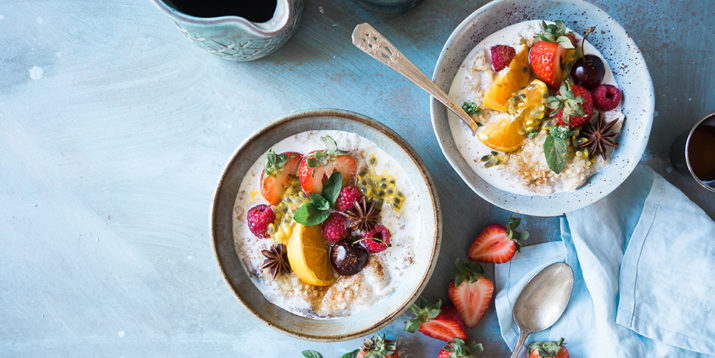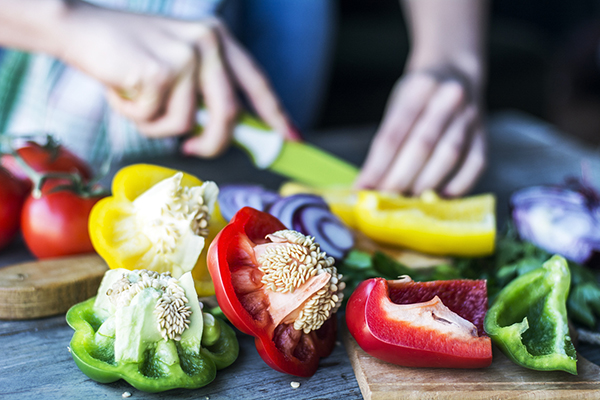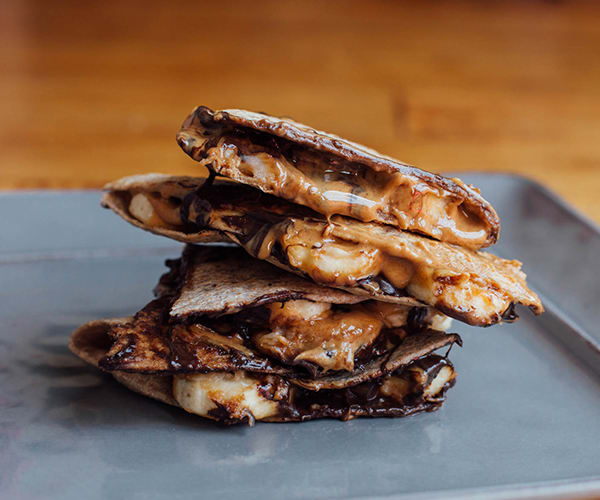8 Healthy Eating Tips to Banish Boring Meals

Let’s face it: “Healthy eating” has a PR problem.
If you’re new to eating healthy, that phrase may bring to mind an unappetizing image of a boring plate of salad topped with grilled chicken next to a piece of fruit.
It’s what you might scoff at as “rabbit food.”
Yes, foods like fruits, veggies, protein, and whole grains are part of a balanced, healthy diet, but that doesn’t mean you’re stuck with plain oatmeal and a banana for breakfast every day.
(Pro tip: A daily Shakeology is an easy, delicious way to jazz up your morning meal. Find your favorite recipe here!)
Whole foods can act as a blank canvas for exciting flavors and textures.
It’s all about targeting your senses by maximizing the deliciousness of your healthy meals, so you’ll want to eat them again and again.
First, let’s explore these senses and how they affect your eating experience.
How Your Senses Affect Your Eating Experience

Eating is all about the senses. Taste, smell, sight, touch, and even sound all play into our enjoyment of food.
Taste
Taste is crucial to appreciating food. You have 10,000 taste buds that are evolutionarily wired to like sweet, salty, and rich (aka, fatty) foods because they contain lots of calories and nutrients compatible with survival.
A study by Yale researchers found that mice genetically bred without the ability to taste sweetness don’t prefer sugar water any more than plain water at first.
After a few days, they learned to prefer the sugar water, likely because it contained a prized reward: calories.
Drinking the sugar water also prompted the release of dopamine, which plays a major role in the reward-motivated behavior of the brain.
True, humans are more complex than mice, but this experiment indicates it’s possible for taste preferences to be rewired.
Smell
Smell works closely with taste to create flavor. There are five tastes (sweet, salty, sour, bitter, umami), but there are thousands of smells to help you recognize what you’re eating.
Smell may also help your brain decide if it should burn or store calories.
An experiment by UC Berkeley researchers found that mice who had their smelling abilities removed could stay trim while eating a high-fat diet, despite eating the same amount as mice with normal smelling abilities.
The science is very new, but if it can translate to human beings, smell could be a target for future weight-loss regimens.
Touch

In the case of eating, touch can be referred to as texture. Texture is worth mentioning because a lot of our comfort foods rely on creamy and crispy textures.
You “taste” fat as the creaminess in cheese, ice cream, and avocado. Crispy textures are common in cookies, fries, and chips.
Both textures can be leveraged to make healthy food tasty.
In the mood for something cold and creamy? Try these recipes:
Chocolate, Peanut Butter, and Banana Sweet Quesadilla
If you prefer crispy/crunchy textures, these recipes will hit the spot:
Baked Corn Tortilla Chips (to go with this flavorful, healthier guacamole, of course!)
Crunchy Spicy Shredded Pork Tacos
Sight
Sight counts; we eat as much with our eyes as we do with our mouths.
There’s a reason why food videos and photos on social media are so popular!
Dr. Brian Wansink of the Cornell Food and Brand Lab found that people are more likely to over-serve themselves if their plate is similar in color to the food they’re eating.
Another reason to add all kinds of color to your cooking!
Sound
Sound can also play a role in your eating experience. You probably know quite a few people who would shun soggy fries and limp bacon, and who can blame them?
The crispiness and crunchiness of some foods can be critical to their enjoyment.
We may have evolved to prefer crunch because it’s a sign of freshness.
A lot of food companies capitalize on this by selling chips, crackers, pretzels, and chocolate chip cookies.
You can capitalize on crunch in your favor when you make healthy snacks like crispy baked zucchini fries.
Sound can negatively affect your food experience, too. Non-food-related sounds such as a noisy restaurant can distract you and depress your overall enjoyment of the meal.
8 Healthy Eating Tips to Banish Boring Meals
We believe healthy eating is about making wholesome foods taste so good you’ll want to eat them all the time. Here are a few culinary tips and recipe suggestions to elevate your healthy eating game:
1. Go for full-flavored salads
Does it bother you to see a 500-calorie salad, but you don’t blink an eye at an 800-calorie cheeseburger?
If so, it’s time to dash that double standard.
A healthy, satiating salad with protein, tons of veggies, flavorful toppings, and a light dressing can provide you with essential nutrients and satisfy all your senses.
While it may sound counterintuitive to add calories just to get you to eat your veggies, it’s entirely possible to jazz them up without sabotaging your weight-loss goals.
But be smart about what you’re adding: Skip calorie bombs like candied nuts, watch portion sizes, and use spices to add flavor and depth.
Add zest to your leafy greens with this Creamy Dill Dressing. Don’t want to give up ranch? Here’s a healthier version.
2. Try a new cooking technique
You know the healthy cooking drill: baked chicken, broiled fish, and hard-boiled eggs ad nauseum.
Switch things up and experiment with new cooking techniques so you can make mouthwatering meals like this Hawaiian Salmon, which uses oven-poaching to keep the fish moist and flavorful.
Different cooking techniques create different smell and flavor compounds that can enhance the taste of food.
Same goes for cooking veggies: We know it’s easy to nuke broccoli in the microwave or steam it on the stove, but think out of the pot and try some of these recipes:
Slow Cooker Mushrooms and Herbs
Grilled Corn With Chili, Cheese, and Lime
3. Be BFFs with your pantry
Salt and pepper alone won’t cut it. You have to learn how to flavor with herbs and spices if you want to whip up tasty meals.
These flavor agents give ingredients their cuisine identity.
Plain Jane chicken, for example, can turn Italian with rosemary and oregano, or Asian with soy sauce and ginger.
Beginner cooks may get overwhelmed by all the variety, so here are a few herbs, spices, and blends to get you started:
- Savory: chili powder, curry powder, rosemary, thyme, paprika, cayenne pepper, oregano.
- Sweet: cinnamon, nutmeg, vanilla extract, cocoa powder.
4. Add some zest to your dish
Squeeze lemon or lime juice over a savory dish to brighten and enhance its flavor, no extra salt needed!
Use lemon in place of vinegar in marinades and salad dressings.
Invest in a zester so you can work the fragrant lemon peel into meat dishes and dessert. Mouthwatering Lemon Garlic Chicken Thighs? Yass!
5. Pretty-up your meals
Plate your food in a way that piques your appetite. Use a variety of fruits, vegetables, and whole grains to add color and (nutrition!) to your meal.
Get creative with presentation and make Sweet Potato Egg Cups for a convenient breakfast, mason jar salads for Instagram-ready lunches, and Turkey Lettuce Wraps for dinner.
6. Health-ify your cravings
Play with flavor and texture to make a healthier version of your favorite comfort foods. If you crave tater tots, try baked cheesy Broccoli Tots.
If you want donuts, try these Baked Pumpkin Donuts. We bet there are healthier variations for any of your food cravings.
(Did someone say “Healthier Mac and Cheese“? Yes, please!)
7. Host a dinner party
Instead of shelling out dough at a restaurant, throw a dinner party to bond with your friends.
Eating with loved ones helps you build more positive memories related to healthy eating. Get them involved in meal prep: Host a build-your-own taco bar or a sushi-rolling party.
8. Add a touch of umami
Umami refers to savory, the fifth taste. There are tons of high-umami foods that can give your healthy dish a flavor punch.
These include caramelized onions, shiitake mushrooms, cheese, ripe tomatoes, chicken broth, fish sauce, and even nutritional yeast.
The Bottom Line
Patience is key. Did you know that it can take upwards of 15 tries before most kids and adults will learn to like a new food?
If you’re someone who has (finally) gotten yourself to crave healthy food, you know it takes time for your eating habits to change.
Be patient and pretty soon you’ll master the art of healthy eating.
